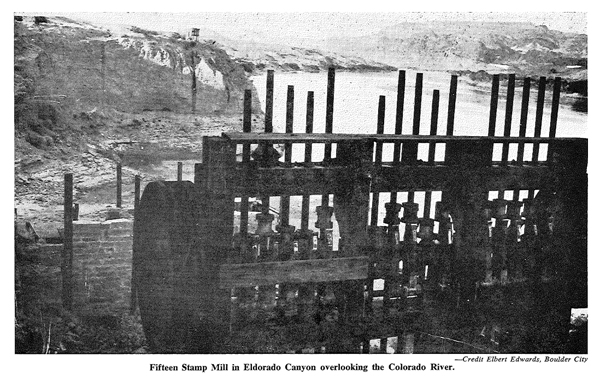Early Development of El Dorado Canyon and Searchlight Mining Districts
INTRODUCTION
The El Dorado-Searchlight area is comprised of two contiguous mining districts situated wholly west of the Colorado River, east of El Dorado Valley, and between Boulder City on the north and Grapevine Canyon on the south. The area enclosed within these somewhat arbitrary boundaries approximates 1,150 square miles. The portions 'of the study area adjacent to the Colorado River lie within the Lake Mead National Recreation Area (Lake Mohave). Access to the study area is easily made from U.S. Highway 95, which parallels the districts as it traces a north-south course through El Dorado Valley. Nevada Highway 60 continues past Nelson to the Colorado River. The road carries much tourist traffic and interconnects with many prospector and jeep trails. The area is well covered by roads in various stages of repair. As the drainage pattern is oriented from west to east, most roads follow an easterly direction from the higher ridges down to the Colorado Valley. Travel on most of the roads of the area is not recommended for ordinary motor vehicles although four-wheel drive units can normally be utilized.
The study area lies in the southern portion of the Great Basin of the western United States. To the west and northwest of the district lies the El Dorado Valley, which includes the Searchlight playa. The valley is generally 6 to 10 miles in width and is approximately 35 miles in length. Drainage from the western slopes of the El Dorado and Newberry ranges flows into El Dorado Valley. Flows deriving from the crest line of the same ranges, but in their eastern half, follow the drainage pattern to the Colorado River. Physiographic ally, the study area is divided into two more or less similar parts. The eastern section belongs to the drainage pattern of the Colorado River, and the western portion is within the Basin and Range Province.
The El Dorado-Searchlight area is geologically a north-south trending orogenous zone, paralleled on the east by the valley of the Colorado, and by an alluvial valley on the west. The successive instrusions of igneous and sub-volcanic lithic masses have created an erosionally positive body that has gradually been eroded into a series of sharp ridges. Valley floor elevation ranges from 2,500 to 3,600 feet (MSL), while the crest line varies between 4,500 and 5,500 feet (MSL).
Annual rainfall averages about 10.5 inches. This usually occurs in the form of violent thunderstorm activity. The fall months are the rainy season, but storms can occur at any time. Snowfall is light to moderate. Moisture derived from snowpack is noticeable enough to substantially effect averages.
The low average moisture is reflected in the climate and flora. The region is an atypical low-altitude desert. Springs occur infrequently and commonly in association with contact zones between intrusive or structural geologic elements.